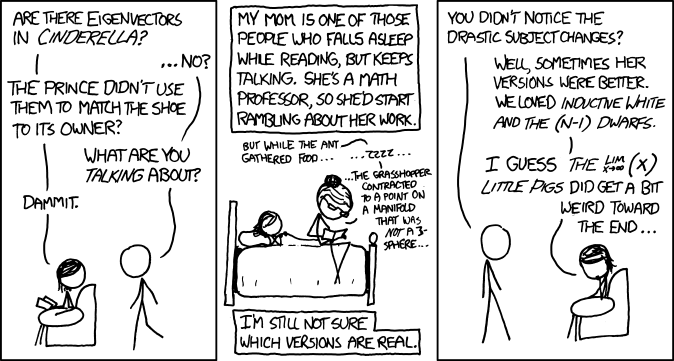
Research Interests
As a Ph.D. candidate, I'm working with Jim Coykendall (and to a lesser extent with Jason Boynton and Sean Sather-Wagstaff) to investigate applying homological results to problems in factorization, number theory, and arithmetic rings. I am particularly interested in looking into homological results related to the groups of divisibility for certain pathological integral domains. My coursework recently revolved around homological algebra, algebraic geometry, and semi-dualizing modules with Sean Sather-Wagstaff, number theory, factorization, integrality, and arithmetic rings with Jim Coykendall, as well as Fourier and functional analysis with Maria de los Ángeles Alfonseca-Cubero.
My history, however, is more biased toward applied mathematics. As an undergraduate, I focused on mathematical models, stochastic dynamical systems, pattern recognition, and the mathematics of large data sets. I studied the statistics of seasonal rabies in bats, simulated plague outbreaks and the evolution of plague resistance in priarie dogs and their fleas, and investigated computer solutions to problems motivated by game theory and evolution. As a masters student, my modeling interests moved toward computational neuroscience.
Publications, Abstracts, Works in Progress, etc
- Coykendall, JB and Goodell, BG. The Group of Divisibility as a Functor. For submission to Journal of Commutative Algebra, 2013. In prep.
- Coykendall, JB and Goodell, BG. A Homological Approach to Factorization. For submission to Crelle's Journal, 2013. Submitted. Preprint on arXiv.
- Buhnerkempem MG, Eisen, RJ, Goodell, BG, Gage, KL, Antolin, MF, et al. (2011) Transmission Shifts Underlie Variability in Population Responses to Yersinia pestis Infection. PLoS ONE 6(7).
- Webb, CT, Goodell, BG, Antolin, MF. (2010) Evolution of resistance in natural hosts of plague (abstract). Vector-borne and zoonotic diseases, volume 10, issue 1 (special issue).
Workshops I've Attended
In Spring 2012, I participated in the Connections between Algebra and Geometry workshop organized by Susan Cooper of Central Michigan University, Sean Sather-Wagstaff or North Dakota State University, and Donald Stanley of the University of Regina. This workshop preceded the CMS special session at the University of Regina, which I also attended.
PhD Dissertation
My dissertation is most likely going to develop some group-homology results as applied to the groups of divisibility and the Picard groups of certain pathological domains. However, I have not yet officially made any decisions in this regard, and am still simply writing some theorems on the topic.
MS Thesis
Hybrid models of neurons are computationally efficient and can recapture biological plausibility. My thesis deeply analyzes a novel hybrid model neuron and assesses its biological plausibility. The model is dependent on two choices of parameter and one choice of a function, f, and dependent on these choices, a variety of dynamical behaviors are observable. Transitioning from one dynamical regime to another is called a bifurcation. I construct a (nearly) complete bifurcation portrait of a novel hybrid model neuron by Izhikevich, which is capable of very rich dynamical behavior.
Project BRAINN
Using Python, Aaron Feickert and I worked toward replicating Izhikevich's paper simulating a large neural network using computationally efficient hybrid model neurons. The network has a biologically plausible distribution of neural types and synaptic connections. Our interest was to couple this neural network to a biologically plausible wavelet decomposition of a two-dimensional image so as to simulate the bottom-up processing of the V1 area of the brain. Our code is here.
Math:
Research |
Talks, Posters, etc. |
Teaching & Courses
Jobs:
Curriculum Vitae |
Research Statement |
Teaching Statement
NDSU Mathematics Dept #2750
1210 Albrecht Blvd, Minard 412
Fargo ND 58103
701.231.8408
brandon.goodell(at)ndsu.edu

